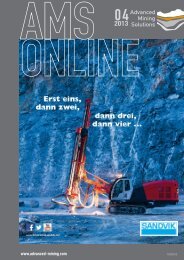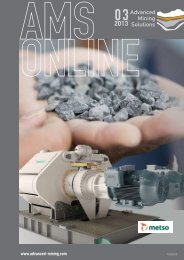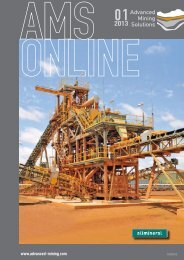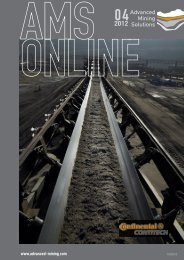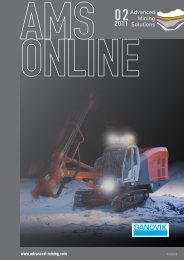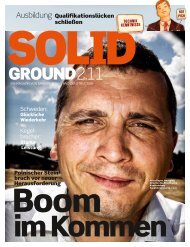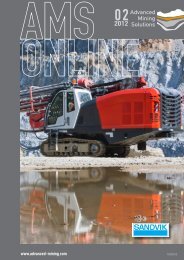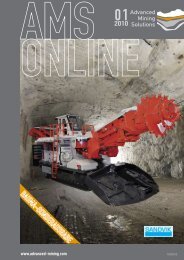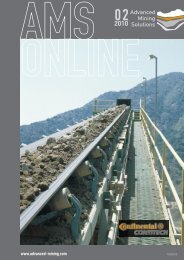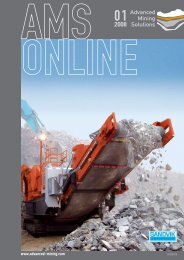A new face drilling rig for narrow tunnels and ... - Advanced Mining
A new face drilling rig for narrow tunnels and ... - Advanced Mining
A new face drilling rig for narrow tunnels and ... - Advanced Mining
Create successful ePaper yourself
Turn your PDF publications into a flip-book with our unique Google optimized e-Paper software.
Characteristic data like active current intake <strong>and</strong> rotation<br />
speeds of the individual screw conveyors are continuously<br />
recorded during the test in the frequency converter. In<br />
addition the measurement technique installed at the test<br />
site allows <strong>for</strong> recording of other important measurement<br />
data. Apart from the inclination of the screw conveyor <strong>and</strong><br />
its filling level, the conveyed mass flow is recorded through<br />
balance weighing of the entire content of the bunker. These<br />
values are also recorded as analog signals in the frequency<br />
converter. The data saved in the frequency converters are<br />
Table 1:<br />
Technical data of the screw conveyors of the test plant<br />
sorted with an analysis software <strong>and</strong> combined in a result<br />
file <strong>for</strong> further processing. Thus the mentioned influencing<br />
factors, rotation speed, filling level <strong>and</strong> inclination can<br />
directly be set or at least be continuously monitored. In<br />
addition to these parameters the characteristics of the<br />
bulk materials also have an influence on the conveying<br />
process <strong>and</strong> the power requirement. There<strong>for</strong>e the tests<br />
were repeated <strong>for</strong> various bulk materials. The parameters<br />
to be examined <strong>and</strong> the respective parameter levels are<br />
summarized in table 2.<br />
Finally, the comm<strong>and</strong> variables to generate the<br />
dimensioning <strong>and</strong> layout guidelines can be calculated from<br />
the recorded data. The empirical coefficient of velocity<br />
ζ* can be calculated from the measured mass flow I m<br />
according to<br />
*<br />
4 ⋅ I m<br />
ζ =<br />
2<br />
ρ ⋅ϕ<br />
⋅<br />
Issue 04 | 2010<br />
2 ( D − d ) ⋅π<br />
⋅ S ⋅ n<br />
(12)<br />
With the bulk density ρ, the filling level φ, , the screw<br />
diameter D, the shaft diameter d, the screw pitch S, as well<br />
as the rotation speed n. At the same time the empirically<br />
determined coefficient of power λ can be calculated from<br />
the recorded active current I Wirk<br />
λ<br />
*<br />
=<br />
3 ⋅U<br />
eff<br />
I<br />
m<br />
⋅ I<br />
Wirk<br />
⋅η<br />
− P<br />
D<br />
⋅ g ⋅ ⋅ L<br />
S<br />
Leer<br />
S ⋅ H<br />
−<br />
D ⋅ L<br />
(13)<br />
TRANSFER OF TECHNOLOGY<br />
Table 2:<br />
Examined parameter levels in the tests<br />
Parameter Unit Parameter levels<br />
Rotation speed n [1/s] 2 3,5 5 6,5 8<br />
Inclination angle β [°] 20 30 40 50 60<br />
Filling level φ [-] 0,2 0,3 0,4 0,5 0,6<br />
Parameter Unit Feeding Device Vertical Conveyor Inclined Conveyor<br />
Conveying length [m] 2 x 0,75 7,0 3,0<br />
Screw diameter [m] 0,4 0,26 0,26<br />
Screw pitch [m] 0,4 0,23 0,23<br />
Maximum rotation speed [1/s] 1,7 9,3 9,3<br />
Installed driving power [kW] 1,5 30,0 15,0<br />
Taking into consideration the effective voltage U eff , he<br />
motor- <strong>and</strong> gear-efficiency η, the idling drive power P Leer ,<br />
the achieved mass flow I m , the conveying length L, the<br />
screw pitch S , the screw diameter D <strong>and</strong> the conveyance<br />
height H.<br />
Simulations according to the Discrete<br />
Element Method<br />
Furthermore, data are obtained through simulations<br />
according to the Discreet Elements Method (DEM). In<br />
principle such simulations are numerical experiments,<br />
in which apart from the geometry of the conveyor, the<br />
individual bulk particles are pictured as discrete elements,<br />
In each calculation step Newtonian equations of motion are<br />
solved <strong>and</strong> allow <strong>for</strong> calculation <strong>and</strong> simulation of discrete,<br />
continuous procedures. In principle this simulation method<br />
is very simple, however previously it was limited by the<br />
very high number of particles to be considered. It was<br />
only by the application of modern computers with multicore<br />
technology <strong>and</strong> high calculation speed that it became<br />
possible to also accurately calculate complex simulations<br />
with several tens of thous<strong>and</strong>s particles <strong>and</strong> high resolution<br />
in acceptable timeframes. The simulation program EDEM<br />
of the DEM Solutions LTD company is applied in this test.<br />
www.advanced-mining.com<br />
49



